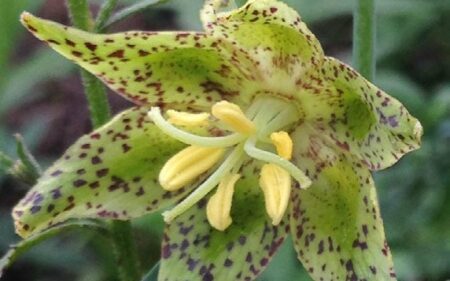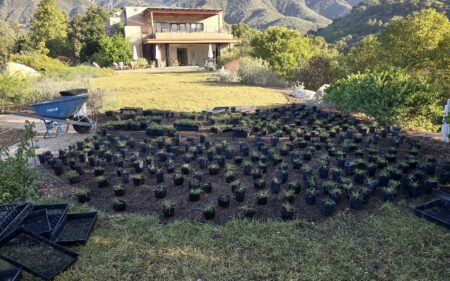Uncovering Two New Novel Plants

A forest of black oak, incense cedar, and Jeffery pine provide shade and fill the air with a woodsy scent on the hike up the mountain. Near the top, these tall trees are replaced by low chaparral shrubs and forbs, which are likely providing forage for black bears and other animals.
These were observations that I made this past field season while visiting an unceded ancestral territory of the Mew-Wuk Tribe. In English, this area is referred to as Bald Mountain and it sits within the Stanislaus National Forest. The Garden’s Rare Plant Conservation team went to this area to survey for Stebbins’ desert parsley (Lomatium stebbinsii) and three bracted onion (Allium tribracteatum) – two rare plants that occur in the treeless zone.
While in the field, we conduct surveys, collect herbarium specimens, and collect seeds from rare plants throughout California – from the Channel Islands to the high ranges of the Sierra Nevada Mountains. Since rare plants often grow in both isolated and unique habitats, our travels offer an opportunity to observe plants in ecosystems that are often understudied – such as the summit of Bald Mountain.
A New Lomatium sp. nov. on Bald Mountain
While surveying for Lomatium stebbinsii, I noticed another Lomatium growing nearby. We presumed the neighboring Lomatium was an undescribed species closely related to large-fruited lomatium (Lomatium macrocarpum). However, the undescribed plant (Lomatium sp. nov.) differs in petal color and in having hairy petals. The large-fruited lomatium has hairless (glabrous) petals, a seemingly subtle but very important difference. This was an exciting discovery because the Bald Mountain plant (Lomatium sp. nov.) is likely of conservation concern as they are only known to grow in the Sierra Nevada Mountains of Tuolumne County. Our work to collect herbarium specimens, record photos and gather other data will allow us to better understand these plants so we can help protect them. We’ll also have an opportunity to describe and name them so other scientists can identify and track their resiliency over time.



Another New Lomatium ssp. nov. on the Channel Islands
While in the field conducting conservation work on the Channel Islands in the unceded ancestral territory of the Chumash, we observed another Lomatium plant that is new to western science. This plant was previously misidentified as caraway leaved lomatium (Lomatium caruifolium ssp. caruifolium) and hog fennel (Lomatium utriculatum). However, it differs from both. I’m in the process of describing it as a new subspecies of caraway leaved lomatium.
So far, I have observed that the fruit (mericarp) of the Channel Islands plant lacks hairs, whereas all mainland relatives have hairy fruits. This plant is rare and endemic to the Channel Islands, making it of conservation concern. Although it has been observed recently on Santa Cruz Island and Santa Rosa Island, it has not been observed on San Miguel Island since 1998. It is also an example of the unique botanical diversity of the Channel Islands, so we want to ensure it persists and continues to support the islands’ incredible native plant and animal communities.
These two discoveries highlight the importance of conducting botanical surveys and of accessing infrequently visited locations. There is still much biodiversity yet to be described by western science. That being said, I think it is important to note that many of the plants being described as “new species”, may not be new to humanity. Many have been long known by indigenous peoples. Sometimes these plants already have names in native cultures, and may be part of a living tradition. I feel honored to work on behalf of The Garden so I can learn more and do what I can to protect native plants for generations to come.
 Donate
Donate




